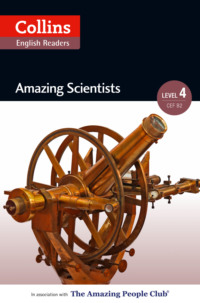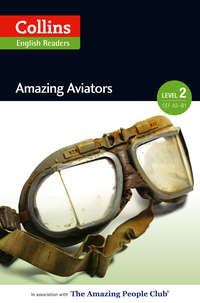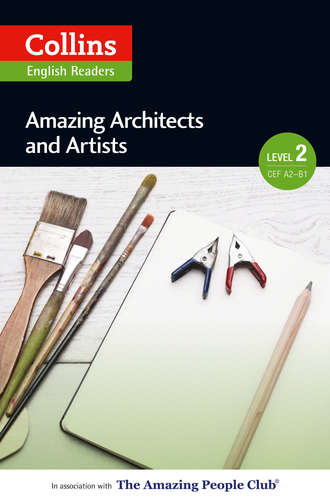
Полная версия
Amazing Architects & Artists: A2-B1




Cover
Title Page
Introduction
The Grading Scheme
Leonardo da Vinci
Christopher Wren
Antoni Gaudí
Pablo Picasso
Frida Kahlo
Glossary
Keep Reading
Copyright
About the Publisher


Collins Amazing People Readers are collections of short stories. Each book presents the life story of five or six people whose lives and achievements have made a difference to our world today. The stories are carefully graded to ensure that you, the reader, will both enjoy and benefit from your reading experience.
You can choose to enjoy the book from start to finish or to dip in to your favourite story straight away. Each story is entirely independent.
After every story a short timeline brings together the most important events in each person’s life into one short report. The timeline is a useful tool for revision purposes.
Words which are above the required reading level are underlined the first time they appear in each story. All underlined words are defined in the glossary at the back of the book. Levels 1 and 2 take their definitions from the Collins COBUILD Essential English Dictionary and levels 3 and 4 from the Collins COBUILD Advanced English Dictionary.
To support both teachers and learners, additional materials are available online at www.collinselt.com/readers.
The Amazing People Club®
Collins Amazing People Readers are adaptations of original texts published by The Amazing People Club. The Amazing People Club is an educational publishing house. It was founded in 2006 by educational psychologist and management leader Dr Charles Margerison and publishes books, eBooks, audio books, iBooks and video content which bring readers ‘face to face’ with many of the world’s most inspiring and influential characters from the fields of art, science, music, politics, medicine and business.


The Collins COBUILD Grading Scheme has been created using the most up-to-date language usage information available today. Each level is guided by a brand new comprehensive grammar and vocabulary framework, ensuring that the series will perfectly match readers’ abilities.
CEF band Pages Word count Headwords Level 1 elementary A2 64 5,000–8,000 approx. 700 Level 2 pre-intermediate A2–B1 80 8,000–11,000 approx. 900 Level 3 intermediate B1 96 11,000–15,000 approx. 1,100 Level 4 upper intermediate B2 112 15,000–18,000 approx. 1,700For more information on the Collins COBUILD Grading Scheme, including a full list of the grammar structures found at each level, go to www.collinselt.com/readers/gradingscheme.
Also available online: Make sure that you are reading at the right level by checking your level on our website (www.collinselt.com/readers/levelcheck).
Leonardo da Vinci

1452–1519
the man who painted the Mona Lisa
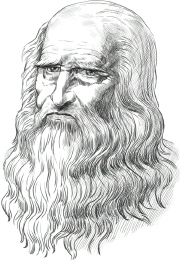
I had many careers during my life. I was a painter, an architect, an engineer and a scientist. But I was also a dreamer who dreamed of the future. Some of the things I dreamed about only happened many years after my death.

I was born, on 15th April 1452, in a village near the Italian town of Vinci. In those days, all the great cities of Italy were separate countries. Vinci belonged to the city of Florence.
My father, Piero Fruosino di Antonio da Vinci, was a lawyer in Florence. My mother, who was called Caterina, was a poor girl from the village. My father gave me a good education, and perhaps he wanted me to become a lawyer like him. However, my interest was in art.
When I was 14, I became an apprentice of the artist Andrea del Verrocchio. I worked with him for ten years while he taught me. He taught me the arts of painting and drawing as well as metalwork and other arts. Soon, I began to help my teacher with his paintings.
I was a good student, and by the age of 20, I was a member of a group of people called the Guild of Saint Luke. Some of the people in this group were artists, but others were doctors. The detailed drawings that artists made of parts of the human body – anatomical drawings – were important for doctors. So the two groups of people spent time together.
I enjoyed making these scientific drawings. But I also made religious pictures. My patrons always wanted these, and I was good at drawing and painting people. I could easily draw things that were in front of me, like many other artists. But I could also draw things that didn’t exist. Having this skill made me an inventor as well as an artist. All my life, I used my imagination, as well as my eyes and hands. I used them all to invent things, as well as to make pictures.

In 1481, the monks at Scopeto commissioned me to make a picture for them. I started work on the painting, which was called The Adoration of the Magi. But I didn’t finish the job. I had to leave Florence suddenly. Why was this? I’d made a musical instrument from silver. It was a kind of harp which looked like a horse’s head. A prince called Lorenzo de’ Medici heard about this instrument. Lorenzo was the ruler of the city at that time. He decided to send me to Milan with the instrument. He wanted to give it to his enemy, Ludovico Sforza, the ruler of Milan. He wanted Florence to make peace with Milan and he hoped that his present could help this to happen.
I did what Lorenzo wanted me to do, and for the next 17 years I spent most of my time working in Milan. It was there in 1483, that I made the first of my two paintings of The Virgin of the Rocks. Two years later, I painted The Lady with an Ermine. These paintings later became very famous. I also designed a kind of parachute at that time.
In 1487, I made a drawing which is also very famous. I was very interested in proportions at that time. And I was interested in the work of Vitruvius. This ancient Roman architect had written a lot about the subject. He thought that there were rules about proportions in nature. And he thought that there were similar rules for the proportions between the different parts of buildings. I agreed with him. My drawing, which is now called The Vitruvian Man, shows a man’s body. The arms and legs of the man are drawn in two different positions. And the man is contained by both a circle and a square. I thought that the proportions between the parts of a human body were interesting. I thought that they were like the proportions in art and architecture and in the rest of nature. I wrote my thoughts about this subject next to my drawing.
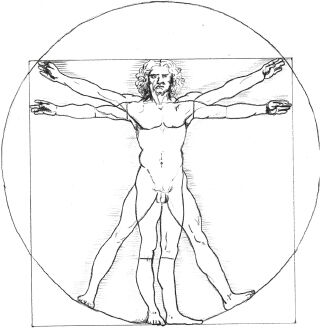
Leonardo da Vinci’s Vitruvian Man
Those years in Milan were very busy for me, and I worked on the cathedral in the city, as well as on paintings for rich patrons. I also made a ceramic model of a horse, called the Gran Cavallo. My idea was to make a very large copy of this model, using the metal called bronze. It didn’t happen – the bronze version was never made. Why? Unfortunately, the government of the city used the bronze to make large guns. They needed guns to defend Milan from its enemies.
While I was in Milan, I heard from my mother. Her health wasn’t good. She came to live with me in 1493, and she died two years later. I went on with my work. Between 1495 and 1498, I created a large mural in a church. The painting was called The Last Supper. But Milan was no longer a safe place, and in 1499, a French army, led by King Louis the Twelfth, invaded the city. I didn’t stay to fight. I was 48 years old and I wasn’t well. I couldn’t fight.

I left Milan and I went to live in Venice. I was too old for fighting, but I could design buildings and machines for defence against enemies. The people of Venice soon asked me to design defences for their beautiful city. So I became a military architect and engineer for a year. But after I finished that work, I didn’t want to stay in Venice. I decided to move back to my home city, Florence.
I enjoyed being in Florence again. I lived in a monastery, so I was able to paint in the monks’ workshop. I used it as my studio. And there were so many beautiful buildings in the city! I loved walking through the streets and looking at the details of the architecture. But I also enjoyed looking at the natural world. I looked especially at the birds. They sang happily and flew happily through the air. ‘If they can fly, why can’t I do that?’ I asked myself. ‘Why can’t men and women fly too?’
That question stayed in my mind, and I made some quick drawings – some sketches. I wanted to invent a flying machine. So I made sketches of flying machines that had moving wings. They were only sketches. ‘But one day,’ I told myself, ‘people will be able to fly.’
I dreamed of flying, but all around me people were talking about war. In 1502, Cesare Borgia, the city’s new leader, asked me to work for him. I designed weapons for him, and military buildings. In those days, I had to spend a lot of time travelling. There were long journeys on bad roads. These journeys were very tiring. Between my travels I tried to paint, but it was difficult to finish many pictures. In 1506, I decided to return again to Milan.
Milan was now a safe place for me, and I had a lot of work to do there. It included many different projects, from church paintings to military designs. I often had to interrupt my artistic work while I did other jobs. Sometimes these interruptions were very long. For example, in 1503, I started painting the Mona Lisa, my most famous portrait, but I wasn’t able to complete it until 1519. During this time, I was able to return to my medical studies. In 1510 and 1511, I cut up dead bodies and made detailed anatomical drawings of parts of them. I completed over 200 of these.
During my life, I made about 2,500 drawings of different kinds. It’s a strange fact that very many of these still exist, but fewer than twenty of my paintings can still be seen. Why is this? Have bad people destroyed them? No, they’ve disappeared and it was my fault. I often made experiments with new kinds of paint. Some of my new paints weren’t very good. Many of my paintings destroyed themselves, because of my bad paints.

In 1513, I moved again. This time, I moved to Rome. The pope asked me to work for him there, and I lived in Rome until 1516. Two famous artists, Raphael and Michelangelo, were also there at the time. We all worked on art projects for churches in the city. This work was interesting, but I had other plans too. I wanted to save people’s lives. I wanted to cut up dead bodies and to study them. I believed that this kind of science – pathology – could help living people. But the pope didn’t agree with me. When he ordered me to stop my medical studies, I decided to leave Rome.
I returned once more to Milan, which the French king, Francis the First, now ruled. I met him and I liked him. Francis was a clever young man with the mind of an artist and we had conversations about many things. He offered me a house in Amboise, in the Loire region of France. The house was near his castle. Francis said that he wanted to learn from me. I accepted his offer and I made the long journey across France. It was a good thing to do. In France, I was given everything that I needed for my work. Most days, the king walked to my house. We discussed my scientific ideas and sometimes we discussed the king’s political problems too. I stayed in France until my death on 2nd May 1519.
I spent much of my time in France writing notes about my ideas. I wanted the scientists of the future to have them. But I made these notes in back-to-front writing, so that no one who came to my house could easily read them. I didn’t want anyone to steal my work while I was alive. In fact, people weren’t able to read these notes until 1651, when they were finally printed in a book. That was over 130 years after my death!
In my notes, I wrote about my work and my life. During my life, I invented new ways of thinking. During my life, I asked new questions about our world and its people. During my life, I studied art, anatomy, architecture, geometry, geology, mathematics, and pathology. And I hoped for a better future.
The Life of Leonardo da Vinci
1452 Leonardo di ser Piero da Vinci was born in the village of Anchiano, near the town of Vinci in Italy. 1467 At the age of 14, he became the apprentice of the artist, Andrea del Verrocchio, in Florence. 1472 Leonardo became a member of the Painters’ Guild of Florence. c.1472–1475 He painted The Annunciation. c.1474–1478 He painted a portrait of Ginevra de’ Benci. 1478 He painted The Benois Madonna (The Madonna with Flowers). 1478–1480 He painted The Madonna of the Carnation (The Madonna with Child). 1480 He painted Saint Jerome in the Wilderness. 1481 Leonardo began work on The Adoration of the Magi, for the monastery of San Donato at Scopeto. 1482 He moved to Milan, and worked for Ludovico Sforza, as a painter and an engineer. 1483 He painted the first version of The Virgin of the Rocks and sketched the design for a parachute. 1485 Leonardo painted The Lady with an Ermine. He also sketched the designs for several military vehicles. 1487 He drew the ‘Vitruvian Man’ with notes, and sketched the design of a fighting ship. 1488 Leonardo designed a city of the future and sketched the designs for a flying machine. 1489–1490 He sketched the design for a kind of computer. 1492 Leonardo completed the ceramic model horse for the Francesco Sforza Monument. The bronze version was never made. 1495–1498 The Last Supper and the second Madonna of the Rocks were painted. 1499–1500 He spent time in Venice before returning to Florence. Leonardo was commissioned to paint The Virgin and Child with Saint Anne and Saint John the Baptist. He finished a sketch for it, but never completed the painting. 1500 Leonardo returned to Florence. He began painting The Virgin and Child with Saint Anne (completed in 1510). He sketched the design for a gun. 1502Конец ознакомительного фрагмента.
Текст предоставлен ООО «ЛитРес».
Прочитайте эту книгу целиком, купив полную легальную версию на ЛитРес.
Безопасно оплатить книгу можно банковской картой Visa, MasterCard, Maestro, со счета мобильного телефона, с платежного терминала, в салоне МТС или Связной, через PayPal, WebMoney, Яндекс.Деньги, QIWI Кошелек, бонусными картами или другим удобным Вам способом.


